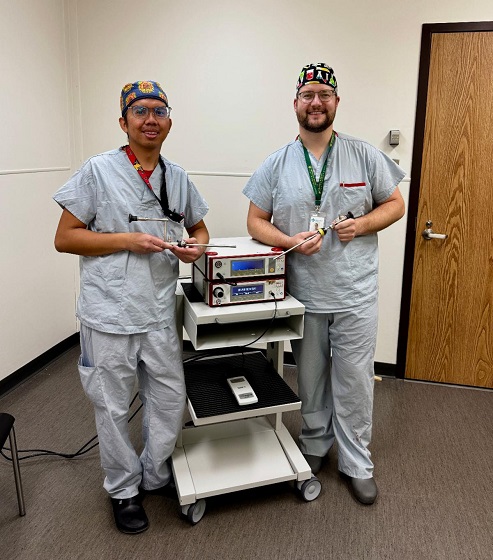Health
Health Foundation supporters responsible for state-of-the-art prostate proceedure at Red Deer Regional Hospital

Registered Nurse Franz Caponpon (left) and Dr. Trevor Haines (right) display new surgical instrumentation funded by the Foundation’s donors.

RDRHF Continues to Help Pave the Way for Cutting-Edge Urology Care
Red Deer Regional Health Foundation donors continue to enhance healthcare for Central Alberta residents, recently playing a key role in bringing an innovative urological procedure to the Red Deer Regional Hospital. The Foundation’s ongoing support has enabled the introduction of the Holmium Laser Enucleation of the Prostate (HoLEP) procedure, a state-of-the-art technique for treating patients with enlarged prostates.
Previously, patients needing this specialized care had to travel to Calgary or Edmonton. With the Foundation’s funding of essential equipment, including complex instrumentation, Red Deer is now one of only three locations in the province capable of performing the HoLEP procedure. This not only keeps patients close to home but also enhances the quality of care in the Central Zone by offering a less invasive, safer alternative for prostate surgery.
“This procedure has been a significant development for surgical care in Red Deer,” said Dr. Haines, the surgeon who performed the first HoLEP procedure in the Central Zone on
September 9th (pictured above, right). “We’re able to offer patients cutting-edge treatment that aligns with the standards of care in larger centers like Calgary and Edmonton. The equipment funded by the Foundation is making a real difference in patient outcomes.”
HoLEP offers numerous benefits, including reduced postoperative bleeding, shorter recovery times, and a less invasive surgical approach. Thanks to donor support, the hospital now has the resources to perform multiple procedures each day, improving access for patients and streamlining care.
“This technology represents a remarkable leap forward,” added Dr. Haines. “Being able to offer such complex surgeries on an outpatient level is revolutionary. Patients can now undergo significant surgery with minimal incisions, reduced pain, and the possibility of next-day or even potentially same-day discharge very soon.”
The Foundation’s investment, which amounted to nearly $300,000, demonstrates its supporters’ commitment to enhancing the healthcare experience for the community. The funds not only covered the purchase of the HoLEP equipment but also ensured the hospital had sufficient resources to maintain consistent patient care.
“The Red Deer Regional Health Foundation has made this possible,” Dr. Haines emphasized. “Without their financial support, we wouldn’t be able to offer this advanced procedure to our patients. It’s a perfect example of how our donors directly impact the quality of care in the Central Zone.”
Thanks to the generosity of our donors and the expertise of local healthcare providers, Red Deer Hospital is establishing itself as a leader in urological care, offering patients top-tier treatment closer to home.

|
|
|
|
|
|
Brownstone Institute
The Unmasking of Vaccine Science

From the Brownstone Institute
By
I recently purchased Aaron Siri’s new book Vaccines, Amen. As I flipped though the pages, I noticed a section devoted to his now-famous deposition of Dr Stanley Plotkin, the “godfather” of vaccines.
I’d seen viral clips circulating on social media, but I had never taken the time to read the full transcript — until now.
Siri’s interrogation was methodical and unflinching…a masterclass in extracting uncomfortable truths.
A Legal Showdown
In January 2018, Dr Stanley Plotkin, a towering figure in immunology and co-developer of the rubella vaccine, was deposed under oath in Pennsylvania by attorney Aaron Siri.
The case stemmed from a custody dispute in Michigan, where divorced parents disagreed over whether their daughter should be vaccinated. Plotkin had agreed to testify in support of vaccination on behalf of the father.
What followed over the next nine hours, captured in a 400-page transcript, was extraordinary.
Plotkin’s testimony revealed ethical blind spots, scientific hubris, and a troubling indifference to vaccine safety data.
He mocked religious objectors, defended experiments on mentally disabled children, and dismissed glaring weaknesses in vaccine surveillance systems.
A System Built on Conflicts
From the outset, Plotkin admitted to a web of industry entanglements.
He confirmed receiving payments from Merck, Sanofi, GSK, Pfizer, and several biotech firms. These were not occasional consultancies but long-standing financial relationships with the very manufacturers of the vaccines he promoted.
Plotkin appeared taken aback when Siri questioned his financial windfall from royalties on products like RotaTeq, and expressed surprise at the “tone” of the deposition.
Siri pressed on: “You didn’t anticipate that your financial dealings with those companies would be relevant?”
Plotkin replied: “I guess, no, I did not perceive that that was relevant to my opinion as to whether a child should receive vaccines.”
The man entrusted with shaping national vaccine policy had a direct financial stake in its expansion, yet he brushed it aside as irrelevant.
Contempt for Religious Dissent
Siri questioned Plotkin on his past statements, including one in which he described vaccine critics as “religious zealots who believe that the will of God includes death and disease.”
Siri asked whether he stood by that statement. Plotkin replied emphatically, “I absolutely do.”
Plotkin was not interested in ethical pluralism or accommodating divergent moral frameworks. For him, public health was a war, and religious objectors were the enemy.
He also admitted to using human foetal cells in vaccine production — specifically WI-38, a cell line derived from an aborted foetus at three months’ gestation.
Siri asked if Plotkin had authored papers involving dozens of abortions for tissue collection. Plotkin shrugged: “I don’t remember the exact number…but quite a few.”
Plotkin regarded this as a scientific necessity, though for many people — including Catholics and Orthodox Jews — it remains a profound moral concern.
Rather than acknowledging such sensitivities, Plotkin dismissed them outright, rejecting the idea that faith-based values should influence public health policy.
That kind of absolutism, where scientific aims override moral boundaries, has since drawn criticism from ethicists and public health leaders alike.
As NIH director Jay Bhattacharya later observed during his 2025 Senate confirmation hearing, such absolutism erodes trust.
“In public health, we need to make sure the products of science are ethically acceptable to everybody,” he said. “Having alternatives that are not ethically conflicted with foetal cell lines is not just an ethical issue — it’s a public health issue.”
Safety Assumed, Not Proven
When the discussion turned to safety, Siri asked, “Are you aware of any study that compares vaccinated children to completely unvaccinated children?”
Plotkin replied that he was “not aware of well-controlled studies.”
Asked why no placebo-controlled trials had been conducted on routine childhood vaccines such as hepatitis B, Plotkin said such trials would be “ethically difficult.”
That rationale, Siri noted, creates a scientific blind spot. If trials are deemed too unethical to conduct, then gold-standard safety data — the kind required for other pharmaceuticals — simply do not exist for the full childhood vaccine schedule.
Siri pointed to one example: Merck’s hepatitis B vaccine, administered to newborns. The company had only monitored participants for adverse events for five days after injection.
Plotkin didn’t dispute it. “Five days is certainly short for follow-up,” he admitted, but claimed that “most serious events” would occur within that time frame.
Siri challenged the idea that such a narrow window could capture meaningful safety data — especially when autoimmune or neurodevelopmental effects could take weeks or months to emerge.
Siri pushed on. He asked Plotkin if the DTaP and Tdap vaccines — for diphtheria, tetanus and pertussis — could cause autism.
“I feel confident they do not,” Plotkin replied.
But when shown the Institute of Medicine’s 2011 report, which found the evidence “inadequate to accept or reject” a causal link between DTaP and autism, Plotkin countered, “Yes, but the point is that there were no studies showing that it does cause autism.”
In that moment, Plotkin embraced a fallacy: treating the absence of evidence as evidence of absence.
“You’re making assumptions, Dr Plotkin,” Siri challenged. “It would be a bit premature to make the unequivocal, sweeping statement that vaccines do not cause autism, correct?”
Plotkin relented. “As a scientist, I would say that I do not have evidence one way or the other.”
The MMR
The deposition also exposed the fragile foundations of the measles, mumps, and rubella (MMR) vaccine.
When Siri asked for evidence of randomised, placebo-controlled trials conducted before MMR’s licensing, Plotkin pushed back: “To say that it hasn’t been tested is absolute nonsense,” he said, claiming it had been studied “extensively.”
Pressed to cite a specific trial, Plotkin couldn’t name one. Instead, he gestured to his own 1,800-page textbook: “You can find them in this book, if you wish.”
Siri replied that he wanted an actual peer-reviewed study, not a reference to Plotkin’s own book. “So you’re not willing to provide them?” he asked. “You want us to just take your word for it?”
Plotkin became visibly frustrated.
Eventually, he conceded there wasn’t a single randomised, placebo-controlled trial. “I don’t remember there being a control group for the studies, I’m recalling,” he said.
The exchange foreshadowed a broader shift in public discourse, highlighting long-standing concerns that some combination vaccines were effectively grandfathered into the schedule without adequate safety testing.
In September this year, President Trump called for the MMR vaccine to be broken up into three separate injections.
The proposal echoed a view that Andrew Wakefield had voiced decades earlier — namely, that combining all three viruses into a single shot might pose greater risk than spacing them out.
Wakefield was vilified and struck from the medical register. But now, that same question — once branded as dangerous misinformation — is set to be re-examined by the CDC’s new vaccine advisory committee, chaired by Martin Kulldorff.
The Aluminium Adjuvant Blind Spot
Siri next turned to aluminium adjuvants — the immune-activating agents used in many childhood vaccines.
When asked whether studies had compared animals injected with aluminium to those given saline, Plotkin conceded that research on their safety was limited.
Siri pressed further, asking if aluminium injected into the body could travel to the brain. Plotkin replied, “I have not seen such studies, no, or not read such studies.”
When presented with a series of papers showing that aluminium can migrate to the brain, Plotkin admitted he had not studied the issue himself, acknowledging that there were experiments “suggesting that that is possible.”
Asked whether aluminium might disrupt neurological development in children, Plotkin stated, “I’m not aware that there is evidence that aluminum disrupts the developmental processes in susceptible children.”
Taken together, these exchanges revealed a striking gap in the evidence base.
Compounds such as aluminium hydroxide and aluminium phosphate have been injected into babies for decades, yet no rigorous studies have ever evaluated their neurotoxicity against an inert placebo.
This issue returned to the spotlight in September 2025, when President Trump pledged to remove aluminium from vaccines, and world-leading researcher Dr Christopher Exley renewed calls for its complete reassessment.
A Broken Safety Net
Siri then turned to the reliability of the Vaccine Adverse Event Reporting System (VAERS) — the primary mechanism for collecting reports of vaccine-related injuries in the United States.
Did Plotkin believe most adverse events were captured in this database?
“I think…probably most are reported,” he replied.
But Siri showed him a government-commissioned study by Harvard Pilgrim, which found that fewer than 1% of vaccine adverse events are reported to VAERS.
“Yes,” Plotkin said, backtracking. “I don’t really put much faith into the VAERS system…”
Yet this is the same database officials routinely cite to claim that “vaccines are safe.”
Ironically, Plotkin himself recently co-authored a provocative editorial in the New England Journal of Medicine, conceding that vaccine safety monitoring remains grossly “inadequate.”
Experimenting on the Vulnerable
Perhaps the most chilling part of the deposition concerned Plotkin’s history of human experimentation.
“Have you ever used orphans to study an experimental vaccine?” Siri asked.
“Yes,” Plotkin replied.
“Have you ever used the mentally handicapped to study an experimental vaccine?” Siri asked.
“I don’t recollect…I wouldn’t deny that I may have done so,” Plotkin replied.
Siri cited a study conducted by Plotkin in which he had administered experimental rubella vaccines to institutionalised children who were “mentally retarded.”
Plotkin stated flippantly, “Okay well, in that case…that’s what I did.”
There was no apology, no sign of ethical reflection — just matter-of-fact acceptance.
Siri wasn’t done.
He asked if Plotkin had argued that it was better to test on those “who are human in form but not in social potential” rather than on healthy children.
Plotkin admitted to writing it.
Siri established that Plotkin had also conducted vaccine research on the babies of imprisoned mothers, and on colonised African populations.
Plotkin appeared to suggest that the scientific value of such studies outweighed the ethical lapses—an attitude that many would interpret as the classic ‘ends justify the means’ rationale.
But that logic fails the most basic test of informed consent. Siri asked whether consent had been obtained in these cases.
“I don’t remember…but I assume it was,” Plotkin said.
Assume?
This was post-Nuremberg research. And the leading vaccine developer in America couldn’t say for sure whether he had properly informed the people he experimented on.
In any other field of medicine, such lapses would be disqualifying.
A Casual Dismissal of Parental Rights
Plotkin’s indifference to experimenting on disabled children didn’t stop there.
Siri asked whether someone who declined a vaccine due to concerns about missing safety data should be labelled “anti-vax.”
Plotkin replied, “If they refused to be vaccinated themselves or refused to have their children vaccinated, I would call them an anti-vaccination person, yes.”
Plotkin was less concerned about adults making that choice for themselves, but he had no tolerance for parents making those choices for their own children.
“The situation for children is quite different,” said Plotkin, “because one is making a decision for somebody else and also making a decision that has important implications for public health.”
In Plotkin’s view, the state held greater authority than parents over a child’s medical decisions — even when the science was uncertain.
The Enabling of Figures Like Plotkin
The Plotkin deposition stands as a case study in how conflicts of interest, ideology, and deference to authority have corroded the scientific foundations of public health.
Plotkin is no fringe figure. He is celebrated, honoured, and revered. Yet he promotes vaccines that have never undergone true placebo-controlled testing, shrugs off the failures of post-market surveillance, and admits to experimenting on vulnerable populations.
This is not conjecture or conspiracy — it is sworn testimony from the man who helped build the modern vaccine program.
Now, as Health Secretary Robert F. Kennedy, Jr. reopens long-dismissed questions about aluminium adjuvants and the absence of long-term safety studies, Plotkin’s once-untouchable legacy is beginning to fray.
Republished from the author’s Substack
Business
Is there a cure for Alzheimer’s Disease?

The Alzheimer’s Lie That Made Big Pharma Billions
The collapse of the Amyloid theory
Remember Aduhelm? It was Biogen’s $56,000/year Alzheimer’s drug that didn’t even work.
Worse, it caused brain swelling, brain bleeding, and sudden falls in patients—and the FDA approved it anyway.
But the truth is, you don’t need deep pockets to treat Alzheimer’s. You just need to look at what Big Pharma can’t monetize.
This report exposes the real causes behind Alzheimer’s—and the cheap treatment options you should explore instead.
The following information is based on a report originally published by A Midwestern Doctor. Key details have been streamlined and editorialized for clarity and impact. Read the original report here.
This information comes from the work of medical researcher A Midwestern Doctor. For all the sources and details, read the full report below.
Why Isn’t There a Cure for Alzheimer’s Disease?
Modern medicine is addicted to the biochemical model of disease because it creates a pipeline for expensive, patentable drugs, and it often leaves patients and their families in the dark, rather than empowered and in control.
It’s not about finding root causes. It’s about finding something you can bill for.
That’s why the industry has spent decades treating Alzheimer’s like a “chemical imbalance” in the brain caused by amyloid plaques—even though hundreds of trials targeting amyloid have failed.
The more the theory collapsed, the harder the system doubled down. Just like cholesterol and heart disease, the medical machine kept pushing the failed model long after it broke.
The amyloid hypothesis was unstoppable. Billions poured in. Researchers who questioned it were pushed to the margins.
Critics called it “amyloid mafia” because no alternative view got funded or even considered.
Meanwhile, real scientists were finding deeper drivers of Alzheimer’s. Things like chronic inflammation, metabolic dysfunction, and mitochondrial collapse.
But these discoveries never gained traction because they didn’t lead to blockbuster drugs.
The entire field locked onto a theory that would never cure the disease but could generate infinite research dollars.
By 2006, the amyloid hypothesis was in trouble. The failed trials and contradictory evidence began piling up and could no longer be ignored. So the medical establishment pivoted instead of admitting any error.
They claimed the real problem was a toxic oligomer called Aβ*56.
An article in Nature declared that they found the smoking gun. It became one of the most cited Alzheimer’s studies ever. The authors became stars. Pharma reinvested billions chasing a new chemical villain.
The field was saved! But there was no truth here, just a convenient new molecule used to justify research funding.
The entire foundation of modern Alzheimer’s research rested on one “blockbuster discovery.” But what if the discovery never existed?
It was a scandal of epic proportions.
A neuroscientist reviewing experimental drug data in 2021 noticed suspicious Western blots. When he looked a little deeper, he found multiple Alzheimer’s papers filled with manipulated images, all traced back to the same author of the famous 2006 study.
So he kept digging. And what he uncovered was stunning!
At least 20 fraudulent papers tied to this researcher, 10 directly involving the molecule the entire amyloid theory now depended on.
The field’s “master proof” was built on completely fabricated data.
Let that sink in.
The NIH was informed in early 2022. And guess what?
They did nothing about it.
Actually, they did worse than nothing—they gave the suspect researcher a $764,792 grant a few months later.
It wasn’t until 2024 that the paper was finally retracted, and even then the authors insisted the fraud didn’t change their conclusions.
Billions of dollars and two decades of research fueled by manipulated images—and the establishment still defended the theory today.
What a joke.
Why are they protecting a disproven model? Why would they continue to push a hypothesis built on doctored data?
Because amyloid research is worth hundreds of billions of dollars—across drugs, trials, funding, and Medicare reimbursements. Seven million Alzheimer’s patients represent an enormous revenue stream.
And with no cure, they’re set to increase customers as people age.
If the amyloid theory collapses, so does the entire financial architecture tied to it. So the system pushes forward—regardless of fraud, failure, or human cost.
And the average person continues to trust this system.
Big Pharma eventually produced monoclonal antibodies that cleared amyloid from the brain. The FDA called it a breakthrough. The investors celebrated. News headlines said there was hope.
Except there was a problem. A big problem. Removing amyloid didn’t actually help anyone.
The first drug, Aduhelm, didn’t improve cognition. At all.
In fact, an FDA advisory panel voted 10–0 against approval, calling it a disaster.
But the FDA approved it anyway. Three advisors resigned in protest, calling it the worst drug decision in modern history!
Why was it so bad? Just take a look at these side effects:
• Brain swelling
• Brain bleeding
• Migraines
• Delirium
• Sudden falls
• Dangerous infusion reactions
Up to 41% of patients experienced serious brain complications.
And it costs a sickening $56,000 per year.
Congress actually launched an investigation. But the FDA still greenlit it—and even quietly approved the next two monoclonals, despite similarly weak results and similarly high risk.
Because it’s not about a cure.
The new drugs caused brain bleeding… but that wasn’t even the most disturbing part.
The incentives behind the approval process will shock you. Don’t miss the full report from A Midwestern Doctor.
Those second and third drugs weren’t much better.
They still caused massive brain swelling and bleeding, just at slightly lower percentages.
And their “benefits” were so tiny—slowing decline by a fraction of a point on a scale where patients need 1–2 points for them and their families to notice anything.
Despite aggressive marketing and FDA cheerleading, the market ultimately rejected these drugs. Aduhelm earned only $5 million before it was pulled. The replacements sold modestly but never lived up to the hype.
Why? Because people quickly realized they didn’t work. Hopeful families didn’t see any improvement. Doctors didn’t either. The risks outweighed the rewards, and thankfully people started to notice.
And yet the system keeps pushing the same model—even as evidence mounts that amyloid might be protective, not harmful.
You read that right. Amyloid may actually be protective.
One of the few successful Alzheimer’s protocols, RECODE, treats amyloid as the brain’s attempt to shield itself from metabolic and inflammatory damage. So removing it may worsen the underlying disease.
This helps explain why amyloid-clearing drugs cause so much harm.
They very well may be ripping off the brain’s band-aids while exposing and ignoring the deeper wounds.
Therapies that do help (and don’t cost an arm and a leg) remain completely ignored.
A trial using MCTs from coconut oil showed 80% of patients improved or stabilized over six months of use. That’s better than any amyloid drug in existence.
Patients around the world have reported similar benefits simply from adding coconut oil to their routine! No side effects. No brain bleeds. And of course, no $30,000 price tag.
The Alzheimer’s story is really a story about American medicine. We don’t have a cure not because the disease is too complex, but because the system isn’t designed to cure anything.
It’s designed to manage your symptoms while profiting off of them.
Until we move away from profit-first frameworks and toward root-cause medicine, we’ll continue to lose the war on chronic disease.
Thankfully, we’re closer now than ever before to making this necessary shift.
If you or someone you love is facing cognitive decline, this report is essential reading. It explains the entire collapse of the amyloid model, the fraud no one wants to talk about, the real mechanisms behind Alzheimer’s, and the natural therapies that actually help.
This thread barely scratches the surface—the full article is one of the most important things you’ll ever read about Alzheimer’s.
Thanks for reading! This information was based on a report originally published by A Midwestern Doctor.
Key details were streamlined and editorialized for clarity and impact. Read the original report here.
-

 National1 day ago
National1 day agoMedia bound to pay the price for selling their freedom to (selectively) offend
-

 Business1 day ago
Business1 day agoIs there a cure for Alzheimer’s Disease?
-

 Bruce Dowbiggin1 day ago
Bruce Dowbiggin1 day agoSometimes An Ingrate Nation Pt. 2: The Great One Makes His Choice
-

 Alberta1 day ago
Alberta1 day agoNew era of police accountability
-

 C2C Journal1 day ago
C2C Journal1 day agoLearning the Truth about “Children’s Graves” and Residential Schools is More Important than Ever
-

 Energy2 days ago
Energy2 days agoCanadians will soon be versed in massive West Coast LPG mega-project
-

 Brownstone Institute1 day ago
Brownstone Institute1 day agoThe Unmasking of Vaccine Science
-

 Artificial Intelligence2 days ago
Artificial Intelligence2 days ago‘Trouble in Toyland’ report sounds alarm on AI toys



















